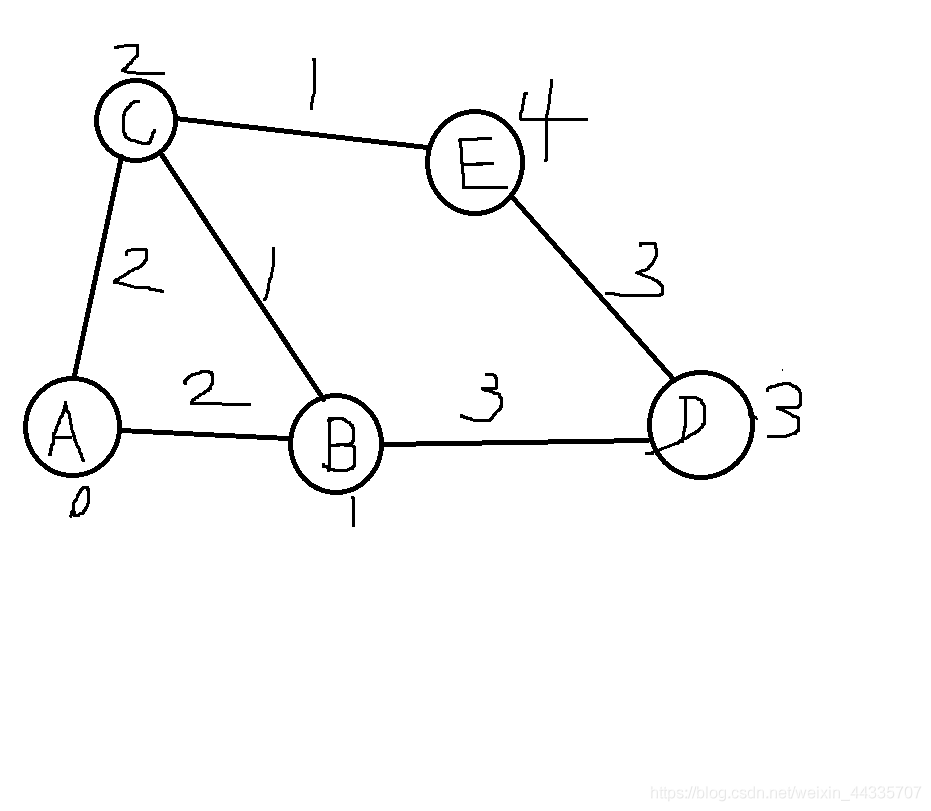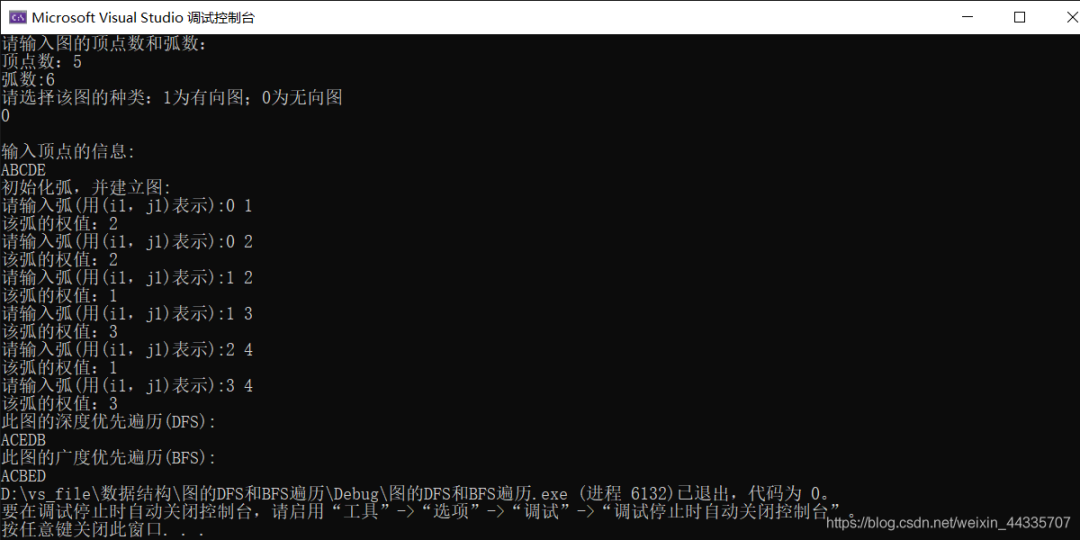头文件
#pragma warning( disable : 4996)
#pragma once
#ifndef _GRAPH_H_
#define _GRAPH_H_
#define MAX_VERTEX_NUM 20
typedef int Graphkind;//有向图该值为1、无向图该值为0
typedef int InfoType;
typedef char VertexType;
//弧节点表示
typedef struct ArcNode {
int adjvex;//弧的下一个顶点的位置
struct ArcNode* nextarc;//指向下一条弧的位置
InfoType info;//弧的相关信息
};
//表头结点
typedef struct VNode{
VertexType data;//顶点的信息
ArcNode* firstarc;//指向顶点的第一条弧的位置
}VNode,AdjList[MAX_VERTEX_NUM];
typedef struct {
AdjList vertices;
int vexnum, arcnum;//图的顶点数目、弧数目
Graphkind kind;
}Graph;
extern int visisted[MAX_VERTEX_NUM];//标记节点还未访问
Graph* creat_graph(Graph* g);//初始化图否被访问,0代表节点未被访问,1代表节点已被被访问
void DFS(Graph* g, int i);//单个节点开始进行深度优先遍历
void Graph_DFS(Graph* g);//整个图的深度优先遍历
void BFS(Graph* g, int i);//单个节点开始进行广度优先遍历
void Graph_BFS(Graph* g);//整个图的广度优先遍历
#endif
头文件中相关函数的定义文件
#include
#include
#include"Graph.h"
int visisted[MAX_VERTEX_NUM];//标记节点还未访问
Graph* creat_graph(Graph* g) {//初始化图
g = (Graph*)malloc(sizeof(Graph));
if (g == NULL) {
printf("内存分配不成功!\n");
exit(-1);
}
printf("请输入图的顶点数和弧数:\n");
printf("顶点数:");
scanf("%d", &g->vexnum);
printf("弧数:");
scanf("%d", &g->arcnum);
printf("请选择该图的种类:1为有向图;0为无向图\n");
scanf("%d", &g->kind);
printf("\n");
printf("输入顶点的信息:\n");
//初始化表头结点
//fflush(stdin);
getchar();
char c;
for (int i = 0; i < g->vexnum; i++) {
scanf("%c", &c);
g->vertices[i].data = c;
g->vertices[i].firstarc = NULL;
}
printf("初始化弧,并建立图:\n");
//初始化弧,并建立图
int i1, j1;
ArcNode* temp;
//fflush(stdin);
getchar();
for (int j = 0; j < g->arcnum; j++) {
printf("请输入弧(用(i1,j1)表示):");
scanf("%d %d", &i1, &j1);
temp = (ArcNode*)malloc(sizeof(ArcNode));
if (temp == NULL) {
printf("内存分配不成功!\n");
exit(-1);
}
temp->adjvex = j1;
temp->nextarc = g->vertices[i1].firstarc;
printf("该弧的权值:");
fflush(stdin);
scanf("%d", &temp->info);
g->vertices[i1].firstarc = temp;
if (g->kind == 0) {//图为无向图
temp = (ArcNode*)malloc(sizeof(ArcNode));
if (temp == NULL) {
printf("内存分配不成功!\n");
exit(-1);
}
temp->adjvex = i1;
temp->nextarc = g->vertices[j1].firstarc;
g->vertices[j1].firstarc = temp;
}
}
return g;
}
//图的深度优先遍历
void DFS(Graph* g, int i) {//单个节点开始进行深度优先遍历
ArcNode* t;
printf("%c", g->vertices[i].data);
visisted[i] = 1;
t = g->vertices[i].firstarc;
while (t) {
if (!visisted[t->adjvex])
DFS(g, t->adjvex);
t = t->nextarc;
}
}
void Graph_DFS(Graph* g) {//整个图的深度优先遍历
int i;
for (i = 0; i < g->vexnum; i++)//将所有结点定义为未访问
visisted[i] = 0;
for (i = 0; i < g->vexnum; i++) {
if (!visisted[i])//如果节点还未访问,则从该节点进行深度访问
DFS(g, i);
}
}
void BFS(Graph* g, int i) {//单个节点开始进行广度优先遍历
int q[MAX_VERTEX_NUM];//用于模拟访问过结点的队列
int front, rear;//front为队列的头部,rear为队列的尾部
int temp;//该变量用于接受出队的元素
front = 0;
rear = 0;
printf("%c", g->vertices[i].data);
visisted[i] = 1;
q[rear++] = i;//模拟入队
ArcNode* p;
while (rear > front) {
temp = q[front++];//模拟出队
p = g->vertices[temp].firstarc;
while (p) {
if (!visisted[p->adjvex]) {
printf("%c", g->vertices[p->adjvex].data);
q[rear++] = p->adjvex;
visisted[p->adjvex] = 1;
}
p = p->nextarc;
}
}
}
void Graph_BFS(Graph* g) {//整个图的广度优先遍历
int i;
for (i = 0; i < g->vexnum; i++)
visisted[i] = 0;
for (i = 0; i < g->vexnum; i++)
if (!visisted[i])
BFS(g, i);
}主程序文件
#include
#include"Graph.h"
int main() {
Graph* G=NULL;
G = creat_graph(G);
printf("此图的深度优先遍历(DFS):\n");
Graph_DFS(G);
printf("\n");
printf("此图的广度优先遍历(BFS):\n");
Graph_BFS(G);
return 0;
}由于测试的图如下所示:
程序的运行结果如下所示: 参考文献:
参考文献:
(1)《数据结构》——严蔚敏 吴伟民 编著
(2)参考的博文链接:[https://blog.csdn.net/Nicht_sehen/article/details/84306286
]
https://blog.csdn.net/weixin_44335707/article/details/104247072





















 451
451











 被折叠的 条评论
为什么被折叠?
被折叠的 条评论
为什么被折叠?








